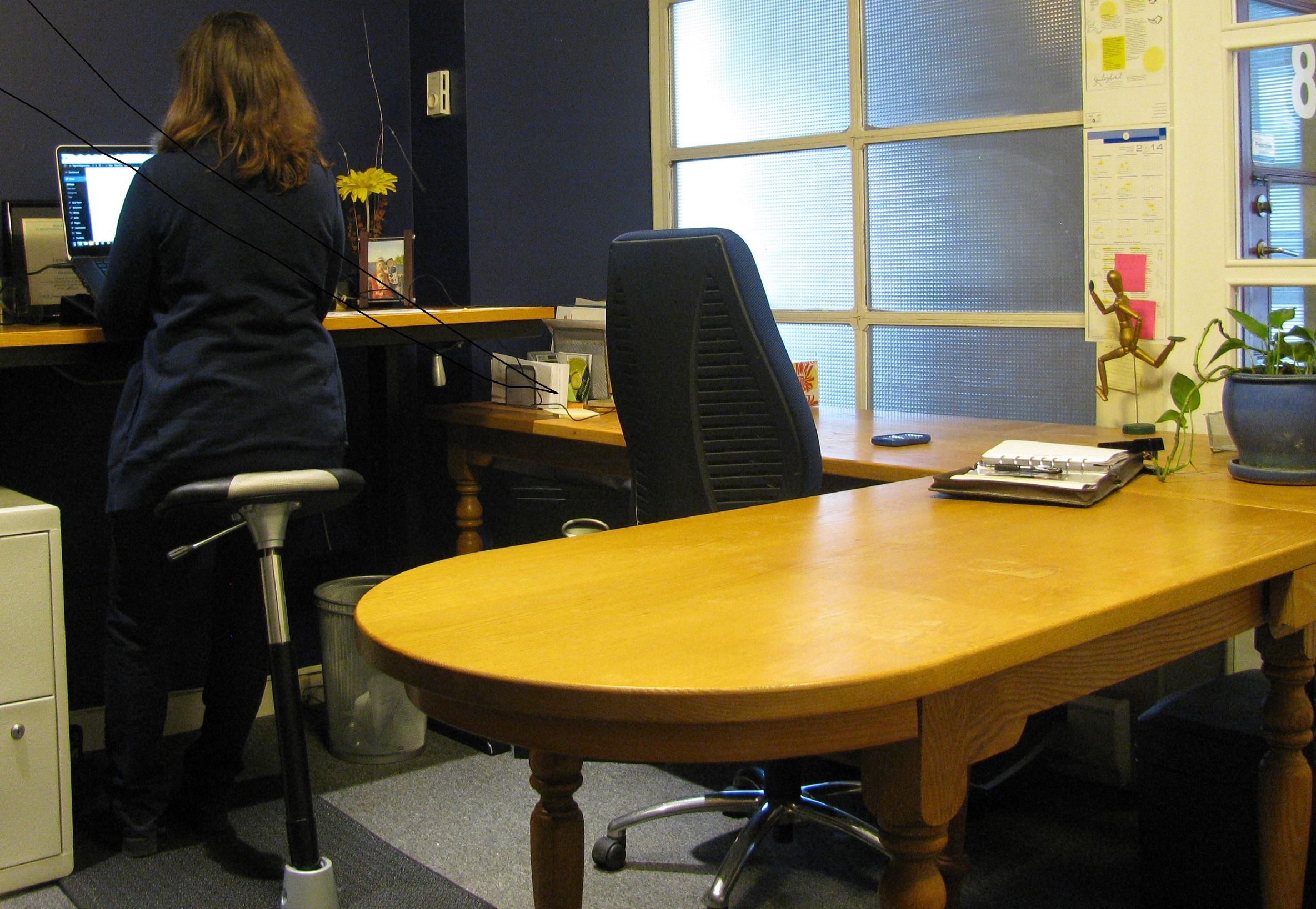Over the holidays, we received a “Posiflex UpRight stand stool” in our office for a trial. I have two workstations in my office – one for sitting and one for standing. I bought the standing station before it was cost-effective for a worksurface to be raised and lowered without a crank. Therefore, I keep it at a standing height all the time. I use a laptop, so it’s very easy for me to move my computer from one workstation to the other. However, like many people who are lucky enough to have the option to sit or stand, I often realise at the end of the day, that I’ve been sitting in my chair all day. Even when I start out standing, I often migrate to my chair after a couple of hours, and I forget to move back to my standing station. And I know better. I am fully aware that “sitting is the new smoking”. I know that standing is better for my back, my heart, and my overall health. I coach our clients to introduce sit/stand options gradually, working up from 10 minutes per hour up to about half the shift. But I must confess that I don’t always follow my own advice.
At the annual Association of Canadian Ergonomists conference in October, we saw the new Posiflex stool at a vendor booth, and we were immediately intrigued. The goal of a stand stool (or leaning stool) is to encourage standing, particularly at workstations where sitting is not practical. For example, if there is not enough leg clearance under the workstatation (for example, at a conveyor), then sitting creates some really awkward back and arm postures. The sit-stand stool helps take some of the load off the feet, making standing a more comfortable option.
The problem with stand stools is that people try to outsmart them. I don’t want to say that people are lazy; I’d prefer to suggest that the human body is innately efficient. It understands that sitting costs less energy, and we’re programmed to conserve energy. (Call it a cave-man instinct, if you like. Nevermind that we no longer need to hunt for food – food energy is all-too-plentiful in today’s society!) When you introduce a stand stool to a workstation where people are standing, they will almost invariably try to sit on it. And the problem with that is that a stand stool is a perfectly horrible chair. It does not provide any back support, is not designed to support the full buttock/thigh (and therefore creates contact pressure somewhere on the back of the thigh) and, if adjusted high enough to optimise arm postures, it will not support the feet.
Why did we immediately like the Posiflex design? The vertical post that the seat is mounted on pivots from the floor – you really cannot sit on this stool because it moves! This encourages you to move your feet and body a bit while you work, and you are always supporting some weight on your feet. And because the post pivots, when you are not sitting on it, the seat stands up behind you, not in your way while you stand to work. The base is a flat steel plate, over which a nice piece of matting sits. When you stand, you stand on comfortable matting. When you lean on the stool, the based can’t slide away.
The folks at Posiflex shipped us one to try here (and with our clients). I put it together this morning, and it’s now 3:00 and I’m still standing….I have not once had the urge to fall into my chair. So far, I have nothing bad to report….my back and legs feel great, and my feet don’t hurt either. Because I have seated and standing work surfaces, I actually have 3 posture choices: stand, stand/lean, or sit. I’m not sure how “alternating between sitting and standing/leaning” would go if I needed to use my chair at the same workstation as my Posiflex, because the sit/stand stool doesn’t easily slide out of the way. However, this device seems perfect for an industrial workstation where operators are standing most of the time. It provides a way to relieve some of the pressure on the feet and legs. I highly recommend this device for work requiring prolonged standing.
Will it work in offices? In large offices with the potential to share workstations (call centers, for example) we often recommend introducing height-adjustable standing workstations that can be used on a first-come basis. Employees log into the computer at that workstation if they prefer to stand. Office managers who provide standing workstations to employees with “medical” justification (a doctor’s note) are often disappointed when these stations are poorly utilised. However, managers in offices with these “shared” standing stations tell us that these workstations are always occupied, which is very encouraging. I think that providing a Posiflex sit/stand stool in conjunction with each shared standing station should further encourage people to stand more, and reduce their risk of injury and illness.
If “Butt out” was an effective smoking cessation campaign tagline, would “Get off your butt” urge people to cease sitting (the “new smoking”)?


